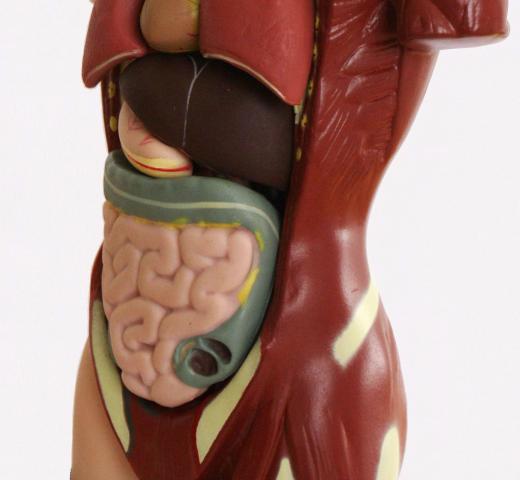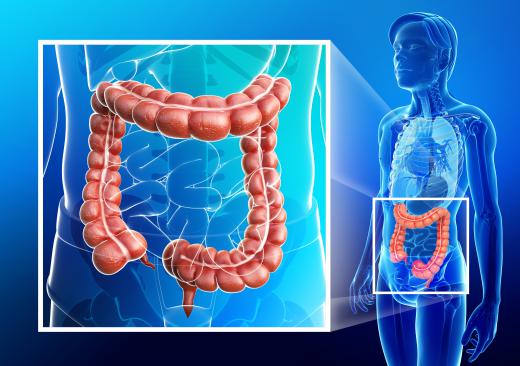What are Some Types of Body Flora?
 Michael Anissimov
Michael Anissimov
The average adult human body has about 1013 cells, around 1600 times greater than the number of human beings on Earth. It is estimated that for every cell in the human body, there are about ten microorganisms, mostly bacteria in the large intestine. This is possible because the volume of a typical bacteria cell may be more than 1000 times less than one of the body's cells.
Along with the bacterial body flora, everyone is also colonized by fungi (mainly yeasts), protists, and archaea (mainly methanogens), although less is known about these because of their scarcity relative to bacteria. In the domain of macroscopic body flora, when found inside the body, these are usually harmful parasites such as tapeworms. However, certain humans may have thousands of macroscopic body flora in their skin or hair, often in the form of mites. Scientists believe there may be as many as a million mite species in the world, adapted to every conceivable environment -- including the human body.

99% of bacteria in the gut comes from 30-40 species. Commonly sighted genera include Bacteroides, Clostridium, Fusobacterium, Eubacterium, Ruminococcus, Peptococcus, Peptostreptococcus, and Bifidobacterium. Bacterial body flora tend to have a symbiotic relationship with their host. Bacteria help digest complex carbohydrates which would be indigestible otherwise, promote growth of intestinal cells, repress pathogenic microbes, prevent allergies, inflammatory bowel disease, and play crucial roles in the immune system. Body flora and the body it occupies have been co-evolving for tens of millions of years.

About 60% of the mass of feces is made up of bacteria. Some bacteria found in the feces can be pathogenic to the person it came from and to people around them. This is part of the reason for modern hygiene. Bacteria spread via feces include E. coli and Vibrio cholerae, the bacterium that causes cholera.
AS FEATURED ON:
AS FEATURED ON:












Discussion Comments
I've been learning about body flora for an assignment and I have been running into a term "microflora" in many places. From what I understand, scientists use microflora when they talk about any microscopic organisms that make up our body flora.
The most interesting one I've read about is the microflora of the intestines because most of the bacteria we have in our body is actually in the large intestines.
Scientists study microflora of the intestines because they say that if there is a disruption or imbalance in it, then the likeliness of becoming ill becomes high. For example, if we use a lot of antibiotics or if we are extremely worried about hygiene and use antibacterials a lot, we can disturb the microflora. Our digestive system might not work properly, or we might get sick more than usual.
So scientist have to know what the microflora of a body system, like the intestines, should be like and how they can get it back to normal if there is a problem.
This is really great information, thanks!
I like @burcidi's comment too. Body flora is different for different people. It's even different depending on the body part in one person!
We learned in biology class that every part and area of the body has its specific flora which is called normal flora. I guess it is called "normal" because it is not harmful to the body in anyway. Like the bacteria in probiotic yogurts. These are part of the normal flora of the digestive system that actually help us digest food.
And then there are harmful bacteria like E. coli that the article mentioned. E.coli is not part of our normal flora and that's why it can be so dangerous for us.
I think everyone's body flora is a bit different. We do have similar flora in the body but some of us may carry bacteria that others don't.
I have experienced this myself when I was given a breath test which showed the presence of a bacteria called helicobacter pylori in my stomach. I had been experiencing severe acid reflux disease for two years and couldn't figure out why. My doctor told me that over 90% of all people carry helicobacter pylori and for most people, it shows no adverse reactions. For some people, they cannot cope with the bacteria and it causes things like hyperacidity and even ulcers.
I took lots of antibiotics for one month to wipe this bacteria out and all of my symptoms completely disappeared. It's so interesting how my body flora didn't have this bacteria as most people do and when I picked it up, it made me sick. And there are so many people who carry it right now and have no problems whatsoever. I find this really interesting.
Post your comments